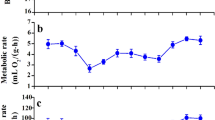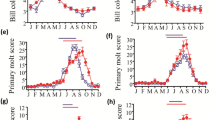Abstract
Many investigations of pineal function have been conducted on animals experiencing artificial laboratory environments. The use of species that naturally experience extreme conditions, such as constant light or darkness, is suggested as a possible way to clarify some of the confusion that exists in the pineal literature at the present time. Arctic species are adapted to an environment in which conditions of constant light are naturally replaced with periods of alternating light. Other conditions of the arctic also vary, including temperature, wind, precipitation, available food, and inter- and intra-species interactions. Arctic species must be highly attuned to their harsh environment. Four species of arctic homeotherms have particular promise as models for the study of pineal function: Snowy owls (Nyctea scandiaca ) and short-eared owls (Asio flammeus ), in contrast with most other owls, must annually switch from being day-active to being at least partially night active. The Arctic fox (Alopex lagopus ) shows regular circannual variations in several parameters alleged to be under the influence of the pineal in other species, including reproduction, activity levels, and seasonal molts. Lemmings (Lemmus trimucronatus ) have two periods of reproductive activity per year, one at the height of the constant light season, and a less intense period that coincides with minimal light. Hormonal activity and possibly pineal activity in lemmings is also implicated in periodic, large scale population fluctuations.
Similar content being viewed by others
References
ANDREWS, R.V., RYAN, K., STROBEHN, R. and RYAN, M. (1972): Physiologic and demographic profiles of brown lemmings during their cycle of abundance. Unpub. final report submitted to the Arctic Institute of North America.
AXELROD, J. (1970): Comparative biochemistry of the pineal gland. Amer. Zool., 10: 259–267.
AXELROD, J. (1974): The pineal gland: a neurochemical transducer. Science, 184: 1341–1348.
HEDLUND, L., RALPH, C.L., CHEPKO, J. and LYNCH, H.J. (1971): A diurnal serotonin cycle in the pineal body of Japanese quail: photoperiod phasing and the effect of superior cervical ganglionectomy. Gen. comp. Endocr., 16: 52–58.
LYNCH, H.J., WURTMAN, R.J., MOSKOWITZ, M.A., ARCHER, M.C. and HO, M.H. (1975): Daily rhythm in human urinary melatonin. Science, 187: 169–171.
MaCPHERSON, A.H. (1969): The dynamics of Canadian Arctic Fox Populations. Canadian Wild. Rep. Ser. 8, Canad. Wild. Ser., Ottawa, 52 pp.
MULLEN, D.A. (1968): Reproduction in brown lemmings (Lemmus trimucronatus ) and its relevance to their cycle of abundance. Univ. of Calif. Pub. in Zool., vol. 85, Univ. of California Press Berkeley, 24 pp.
PELHAM, R.W. and RALPH, C.L. (1972): Diurnal rhythm of serum melatonin in chicken: abolition by pinealectomy. Physiologist, 15: 236.
PITELKA, F.A. (1973): Cyclic pattern in lemming populations near Barrow, Alaska. In: Alaskan Arctic Tundra. M.E.Britton (ed.), Arctic Institute of North America, Tech. Paper 25, 199–215.
QUAY, W.B. (1970): Endocrine effects of the mammalian pineal. Amer. Zool., 10: 237–246.
RALPH, C.L. (1970): Structure and alleged functions of avian pineals. Amer. Zool., 10: 217–236.
RALPH, C.L., LYNCH, H.J., GUNDY, G.C. and HEDLUND, L. (1970): Pineal function and oviposition in Japanese quail: superior cervical ganglionectomy and photoperiod. Science, 170: 995–997.
REITER, R.J., SORRENTINO, S. Jr. (1970): Reproductive effects of mammalian pineal. Amer. Zool., 10: 247–258.
REITER, R.J., VAUGHAN, M.K., BLASK, D.E. and JOHNSON, L.Y. (1974): Melatonin: its inhibition of pineal antigonadotrophic activity in male hamsters. Science, 185: 1169–1171.
RUST, C.C. and MEYER, R.K. (1969): Hair color, molt, and testis size in male, short-tailed weasels treated with melatonin. Science, 165: 921–922.
THOMPSON, D.Q. (1960): The ecology and population dynamics of the brown lemming (Lemmus trimucronatus ) at Point Barrow, Alaska. Ph.D. Thesis, University of Missouri.
UNDERWOOD, L.S. (1971): The bioenergetics of the arctic fox (Alopex lagopus L. ). Ph.D. Thesis, Pennsylvania State University.
UNDERWOOD, L.S. (1975): Notes on the arctic fox (Alopex lagopus ) in the Prudhoe Bay area of Alaska.
VIBE, C. (1967): Arctic animals in relation to climatic fluctuations. Medd om gron., 170: 101–150.
Author information
Authors and Affiliations
Additional information
Presented during the Seventh International Biometeorological Congress, 17–23 August 1975, College Park, Maryland, USA.
Rights and permissions
About this article
Cite this article
Underwood, L.S. Continuous light and physiology of arctic birds and mammals. Int J Biometeorol 19, 304–310 (1975). https://doi.org/10.1007/BF01451041
Issue Date:
DOI: https://doi.org/10.1007/BF01451041




